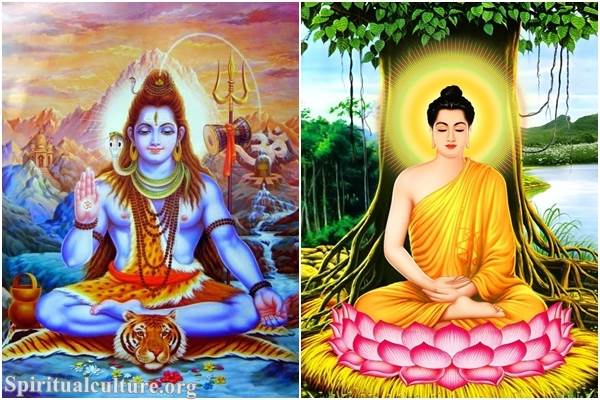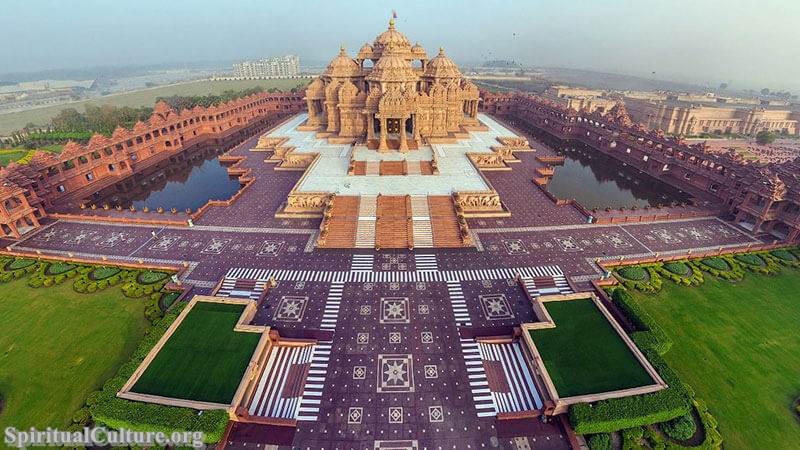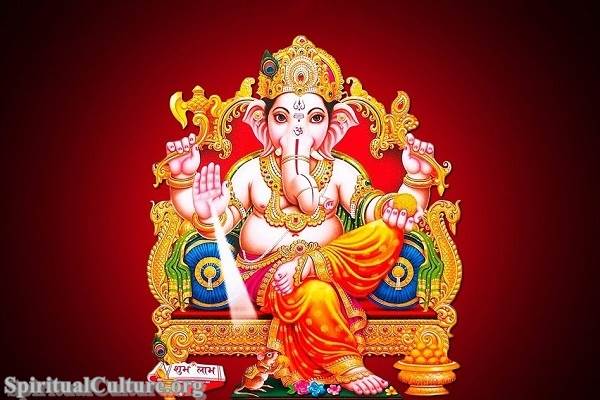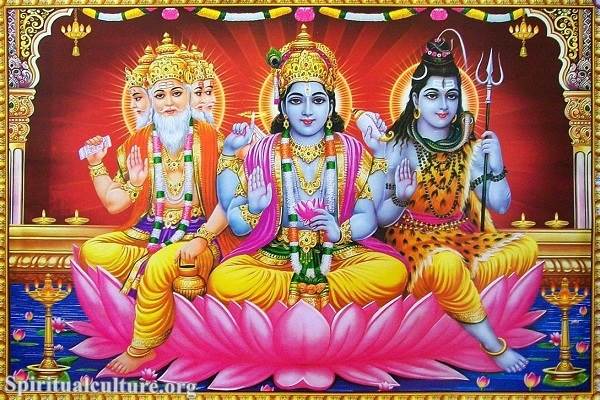In Hindu mythology, Brahma holds a pivotal role as the Creator of the universe, the architect of reality itself. Yet, despite his immense importance, the stories surrounding his own origin are as complex and nuanced as the vast cosmos he is said to have fashioned.
In this article, Spiritual Culture embarks on an in-depth exploration of who created Brahma, delving into the rich tapestry of myths, metaphysical concepts, and cultural significance that surround this enigmatic deity.
The Origins of Brahma in Hindu Mythology
Creation Myths Involving Brahma
Brahma’s genesis is intricately tied to the broader narrative of the universe’s creation, with various myths offering different perspectives on how he came into being. One of the most ancient and widely revered creation myths is found in the Rigveda, where Brahma is said to have emerged from the Hiranyagarbha, the “golden egg” or “golden womb.” This cosmic egg floated in the primordial waters of the universe, an undifferentiated, boundless ocean that existed before the dawn of time. The egg eventually split open, giving birth to Brahma, who then set about creating the world.
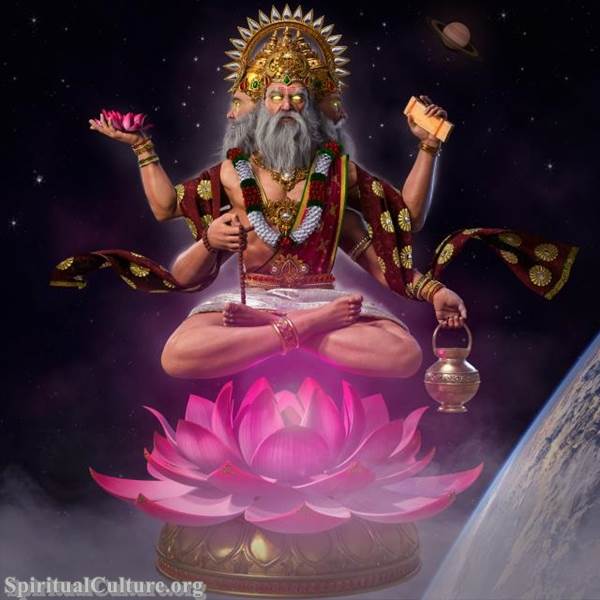
This myth is deeply symbolic. The golden egg represents the potential of the universe, a vessel containing all the possibilities that would later manifest as the material world. Brahma’s emergence from this egg signifies the actualization of these possibilities, the moment when the abstract becomes concrete, when chaos gives way to order.
The Role of Vishnu in Brahma’s Birth
Another significant strand in the mythology surrounding Brahma’s creation involves the deity Vishnu, who plays a crucial role in the cosmic order as the preserver. According to various Puranic texts, Brahma did not simply appear from the golden egg; instead, he was born from a lotus that sprouted from the navel of Vishnu. This imagery is rich in symbolism and serves to highlight the interconnectedness of the divine forces in Hindu thought.
Vishnu is often depicted reclining on the cosmic serpent Ananta Shesha, floating on the infinite ocean of milk, a metaphor for the primordial waters. In this state of yogic sleep, known as Yoga Nidra, Vishnu dreams the universe into existence. From his navel, a lotus emerges, and within that lotus sits Brahma, ready to bring the dream to life. This narrative emphasizes the interdependence of the deities within the Trimurti—Brahma, Vishnu, and Shiva—where Vishnu’s preservation allows for Brahma’s creation, and ultimately, Shiva’s destruction leads to renewal.
The Concept of Hiranyagarbha
The concept of Hiranyagarbha, the golden womb or egg, is central to understanding Brahma’s creation. In Hindu cosmology, Hiranyagarbha is considered the source of the universe, the seed from which all life springs. It represents the unmanifested, potential-filled state of the cosmos before it takes form.
Brahma’s birth from this cosmic womb is not merely a story of divine origin but a profound philosophical statement. It reflects the cyclical nature of creation in Hinduism, where the universe undergoes endless cycles of creation, preservation, and destruction. Brahma’s role as the first being to emerge from Hiranyagarbha underscores his position as the initiator of these cycles, the one who sets the wheel of time in motion.
Brahma’s Family and Relationships
Brahma’s Consorts: Saraswati and Gayatri
In Hindu mythology, Brahma is not a solitary figure. His creative power is complemented and enhanced by his consorts, the goddesses Saraswati and Gayatri. These divine relationships are more than just mythological narratives; they symbolize the essential forces that sustain the act of creation.
Saraswati, often depicted as a serene figure playing the veena (a stringed musical instrument), is the goddess of wisdom, knowledge, and the arts. She embodies the intellectual and creative energy that Brahma requires to shape the universe. The union of Brahma and Saraswati signifies that creation is not a random act but one guided by knowledge and understanding. Without Saraswati’s wisdom, Brahma’s creation would lack purpose and harmony.
Gayatri, another form of Saraswati or sometimes regarded as a separate goddess, is associated with the Gayatri Mantra, one of the most sacred hymns in Hinduism. This mantra, chanted daily by devout Hindus, is a prayer for enlightenment and spiritual awakening. Gayatri represents the spiritual power behind Brahma’s creation, the divine energy that infuses life with consciousness and awareness.
The Significance of Brahma’s Children
Brahma’s role as the Creator extends beyond the formation of the physical universe; he is also credited with the creation of the progenitors of various life forms. His children, known as the Prajapatis, are considered the forefathers of all living beings. Among them, the Saptarishi, or the seven great sages, hold a particularly esteemed position.
The Saptarishi are revered as the patriarchs of human civilization, the transmitters of Vedic knowledge, and the guardians of dharma (cosmic law). According to Hindu tradition, they are immortal beings who oversee the moral and spiritual order of the world, guiding humanity through their wisdom and teachings. The creation of these sages by Brahma highlights his role not just as a physical creator but as a spiritual guide, responsible for the dissemination of knowledge and the maintenance of cosmic order.
Genealogy of the Trimurti
The Trimurti, consisting of Brahma, Vishnu, and Shiva, forms the triad of the most important deities in Hinduism, representing creation, preservation, and destruction, respectively. The genealogy of the Trimurti is a complex web of relationships that reflects the interconnectedness of these divine forces.
While Brahma is the creator, his existence and actions are deeply influenced by Vishnu and Shiva. The Puranic texts often depict Brahma as being born from Vishnu, while his creations are ultimately subject to the cycles of destruction and renewal governed by Shiva. This dynamic relationship between the three deities underscores a key concept in Hindu philosophy: the universe is not a static entity but a constantly evolving process, where creation, preservation, and destruction are interdependent and essential aspects of the divine play.
Symbolism Associated with Brahma’s Creation
The Four Faces of Brahma
Brahma is traditionally depicted with four faces, each facing one of the cardinal directions. These four
faces hold deep symbolic significance, representing not only Brahma’s all-encompassing nature but also his connection to the four Vedas—Rigveda, Yajurveda, Samaveda, and Atharvaveda. These sacred texts are considered the foundational scriptures of Hinduism, containing the spiritual knowledge and rituals that guide the religion.
Each face of Brahma is said to recite one of these Vedas, signifying that he is the embodiment of all knowledge, both sacred and secular. This depiction emphasizes Brahma’s role as the ultimate source of wisdom and the overseer of the cosmic order. The four faces also represent the four Yugas or ages of the world, highlighting the cyclical nature of time in Hindu cosmology. By encompassing all directions and all time, Brahma is seen as the ever-present and eternal force behind creation.
The Significance of the Golden Egg
The golden egg, or Hiranyagarbha, is one of the most profound symbols in Hindu mythology. It represents the unmanifested, potential-filled state of the cosmos before creation begins. The egg is a universal symbol of life and creation, found in many cultures and mythologies worldwide, but in the context of Hinduism, it carries a deeper, metaphysical meaning.
Brahma’s emergence from the golden egg signifies the moment when the universe moves from potentiality to actuality. The egg’s golden color symbolizes purity, perfection, and the divine nature of the creation process. This imagery suggests that the universe, though filled with imperfections and challenges, originated from a perfect and divine source. The breaking of the egg to reveal Brahma is a powerful metaphor for the birth of the cosmos, the moment when the latent energies of the universe are unleashed to create the material world.
Brahma’s Traditional Attributes
In addition to his four faces, Brahma is typically depicted with four arms, each holding a symbolic object that reflects his creative power and authority. These attributes are essential to understanding Brahma’s role in Hindu mythology and cosmology.
- Vedic Manuscript: In one hand, Brahma holds a Vedic manuscript, representing the sacred knowledge and the importance of the Vedas in the process of creation. The Vedas are not just religious texts but are seen as the blueprints for the universe, containing the laws that govern all aspects of existence.
- Rosary (Mala): Another hand holds a rosary, symbolizing time and the continuous cycle of creation. The beads of the rosary represent the countless moments that make up time, and the act of counting them reflects the passage of time, which is under Brahma’s control.
- Water Pot (Kamandalu): The water pot symbolizes the primordial waters from which all life arises. Water is the source of life, and by holding this pot, Brahma signifies his control over the creation and sustenance of life in the universe.
- Lotus: The lotus is a recurring symbol in Hindu iconography, representing purity, beauty, and the unfolding of creation. Just as the lotus rises pure and unsullied from muddy waters, the universe, under Brahma’s guidance, emerges from the chaos of the primordial state into an ordered and harmonious existence.
These traditional attributes highlight Brahma’s multifaceted role as the creator, preserver of sacred knowledge, and guardian of time. Together, they paint a picture of a deity who is deeply intertwined with every aspect of existence, from the spiritual to the material.
Historical Context of Brahma’s Role
Brahma in Early Hindu Texts
In the earliest Hindu texts, particularly the Vedas and the Upanishads, Brahma is celebrated as the supreme creator, the one who brought the universe into existence. The Vedic hymns, some of the oldest religious texts in the world, frequently invoke Brahma as the source of all creation, and rituals dedicated to him are among the most ancient in Hindu tradition.
The Upanishads, philosophical texts that explore the nature of reality and the self, further elaborate on Brahma’s role in the cosmos. They describe him not just as a creator, but as the cosmic principle of creation—an embodiment of the Brahman, the ultimate reality that underlies and pervades the universe. In these texts, Brahma is often equated with the creative aspect of Brahman, making him both a personal deity and an abstract principle.
The Shift in Worship from Brahma to Other Deities
Over time, the direct worship of Brahma began to decline as other deities, particularly Vishnu and Shiva, rose to prominence. This shift is evident in the Puranas, a genre of ancient Hindu texts that focus on the stories of the gods. In these texts, Vishnu and Shiva are often portrayed as more accessible and relatable deities, embodying qualities that resonate more closely with human experience—Vishnu as the preserver and protector, and Shiva as the destroyer and renewer.
Brahma, on the other hand, is seen as a more distant, abstract figure, associated with the lofty act of creation but less involved in the day-to-day affairs of the universe. As a result, temples dedicated to Brahma became fewer, and his presence in religious rituals diminished. However, his importance as part of the Trimurti, the threefold manifestation of the divine, ensured that he remained a key figure in Hindu theology.
Brahma’s Declining Influence in Modern Hinduism
In contemporary Hinduism, Brahma’s influence has waned considerably. While Vishnu and Shiva continue to be the focus of widespread devotion and have numerous temples dedicated to them, Brahma is worshipped in only a few temples, the most famous being the Brahma Temple in Pushkar, Rajasthan.
This decline in Brahma’s worship is often explained through various mythological stories that depict Brahma as having committed certain transgressions, leading to curses that limit his worship. For instance, one popular story recounts how Brahma lied to Shiva in a contest of supremacy, leading to a curse that he would not be widely worshipped. These narratives, while symbolic, reflect the cultural and religious shifts that have occurred over time, as different aspects of the divine became more relevant to the needs and experiences of the people.
Despite this decline, Brahma’s role as the creator remains acknowledged, particularly in philosophical and theological discussions. He is respected as the originator of life and the initiator of the cosmic cycle, even if he is not the central focus of worship.
Comparative Analysis of Brahma’s Creation Stories
Brahma vs. Other Creator Deities in World Mythology
The concept of a creator deity is a common theme in many world mythologies, and Brahma’s role as the Creator in Hinduism can be compared with other similar figures in different cultures. For example, in Greek mythology, Zeus is the king of the gods and a creator figure, though his role is more complex and involves aspects of both creation and governance. In Egyptian mythology, Ra is the sun god and creator of life, often depicted as the force that brings light and order to the universe.
However, Brahma’s creation myths, particularly those involving the lotus or the golden egg, are unique in their emphasis on symbolism and the interconnectedness of divine forces. While many creator deities are portrayed as solitary figures, Brahma’s creation is deeply linked with the actions and presence of other deities, such as Vishnu and Shiva. This reflects the Hindu worldview, which sees the universe as a complex web of relationships and interdependencies.
Thematic Similarities and Differences
Across different cultures, creation myths often share common themes, such as the emergence of order from chaos, the separation of the heavens and the earth, and the establishment of natural laws. In Hindu mythology, these themes are present in the story of Brahma’s creation and his role in shaping the cosmos.
However, Hindu creation myths also incorporate unique elements, such as the cyclical nature of time and the concept of cosmic balance maintained by the Trimurti. Unlike many other mythologies where creation is a one-time event, Hinduism views creation as an ongoing process, with the universe constantly being created, preserved, and destroyed in endless cycles. Brahma’s role as the creator is not a singular event but part of this continuous process, highlighting the dynamic and ever-changing nature of the cosmos.
Cultural Impact of Brahma’s Creation
Brahma in Art and Literature
Throughout the history of Hinduism, Brahma has been a prominent figure in art and literature. His depiction in temples, sculptures, and paintings often emphasizes his role as the creator, with his four faces and four arms symbolizing his all-encompassing power and wisdom. These artistic representations serve not only as religious icons but also as visual metaphors for the philosophical concepts associated with Brahma.
In literature, Brahma’s stories are recounted in various sacred texts, including the Puranas and the Mahabharata, where his role in the creation of the world is explored in detail. These narratives have influenced not only religious thought but also cultural expressions in the form of poetry, drama, and folklore. The stories of Brahma’s creation, his interactions with other gods, and his role in the cosmic order continue to inspire artists and writers, contributing to the rich tapestry of Hindu cultural heritage.
The Legacy of Brahma in Contemporary Hinduism
Despite the decline in his worship, Brahma’s legacy remains significant in contemporary Hinduism. His role as the Creator is acknowledged in religious discourse, and his image continues to be revered in philosophical discussions and spiritual teachings. Festivals such as Navaratri occasionally include rituals that honor Brahma, reflecting his enduring importance in the broader context of Hindu worship.
In modern times, Brahma’s symbolism as the creator has also found resonance in the context of spiritual and environmental movements that emphasize the interconnectedness of all life and the responsibility of humans to preserve the balance of nature. The idea that creation is an ongoing, dynamic process, rather than a static event, aligns with contemporary views on ecology and sustainability, where the focus is on maintaining harmony with the natural world.
Through art, literature, and religious practice, Brahma’s influence persists, reminding us of the intricate and profound myths that continue to shape Hinduism and the lives of those who follow it.
